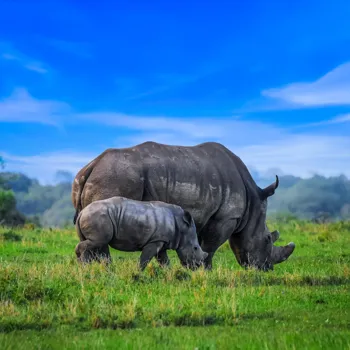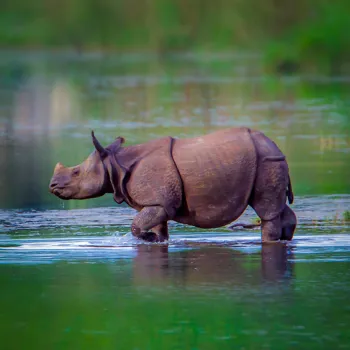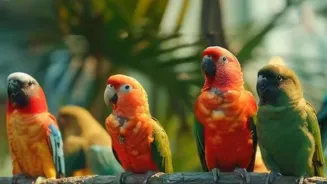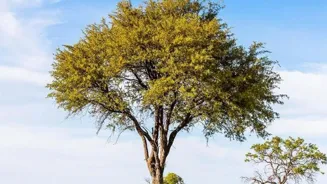Discover the remarkable Indian rhino: a conservation success story with 10 unique traits. Delve into their world now!
The Indian rhinoceros, also known as the greater one-horned rhino, is a magnificent
creature endemic to the Indian subcontinent.

Once teetering on the brink of extinction, primarily due to poaching and habitat loss, the Indian rhino has made a remarkable comeback, largely thanks to stringent conservation efforts across India and Nepal.
This success story is not just about numbers; it's about understanding and appreciating the unique characteristics of this ancient animal. Let's delve into ten fascinating traits that make the Indian rhino truly special. Their thick skin, folded like armor, is a defining characteristic.
This adaptation allows them to navigate thorny vegetation and ward off predators effectively as a protective outer layer. The single horn, a structure composed of keratin. The Indian rhino is the largest of the rhino species, further adding to its impressive presence in the wild.
Indian rhinos have unique thick, armor-like skin for protection
The most striking feature of the Indian rhino is undoubtedly its thick, grey-brown skin. It appears almost like a suit of armor, divided into distinct folds, giving it a prehistoric look. This "armor plating" isn't just for show; it's a functional adaptation.

The thick skin, often covered in mud, helps regulate the rhino's body temperature and protect it from insects and the harsh sun. The folds, particularly around the neck and legs, allow for flexibility and movement as they can easily run. They possess a single horn.
Unlike the horns of African rhinos, which are made of bone and keratin, the horns of Indian rhinos are composed entirely of keratin, the same material that makes up our fingernails and hair.
The size and shape of the horn vary among individuals, and while poaching for rhino horn remains a serious threat, the horn continues to be an essential part of the rhino's defense mechanism and social interactions.
Indian rhino: single horn made of keratin used for defense
Unlike its African cousins, the Indian rhino possesses only one horn, hence the moniker "greater one-horned rhino." This horn is not a true horn in the biological sense, as it lacks a bony core. It's composed entirely of keratin, the same material that makes up our fingernails and hair.
The horn grows continuously throughout the rhino's life and can reach impressive lengths. While the horn is primarily used for defense and digging for roots and tubers, male rhinos also use it during territorial disputes and courtship rituals.
But, the rhino populations are on the rise and a commendable conservation effort. The unique skin folds and the single horn make the Indian rhino easily distinguishable from other rhino species. The single horn is the distinctive feature. This one horn helps them in self-defense.
Indian rhinos communicate through vocalizations and scent marking, aiding community and conservation
Indian rhinos are predominantly solitary animals, except during mating season or when mothers are raising their young. They communicate with each other through a variety of vocalizations, including grunts, roars, and squeals. Scent marking is another crucial form of communication.
Rhinos deposit dung in communal middens, marking their territory and conveying information about their presence and status to other rhinos. These middens can be quite large and serve as "rhino bulletin boards." When we talk about communication, we should know their senses are extremely sharp.
Their sense of smell and hearing help them to be aware of their surroundings. Good communication helps them to build a community and conserve their population.
Indian rhinos agile, fast runners, swimmers, escape heat, predators in wetland habitats
Though they appear heavy and cumbersome, Indian rhinos are surprisingly agile and can run at speeds of up to 55 kilometers per hour for short distances. They are also excellent swimmers and often spend time wallowing in water or submerged in rivers to cool off and escape the heat.
Their agility and swimming abilities are crucial for navigating their wetland habitat and avoiding predators. The rhinos are fond of living in areas with tall grasses or forests in the region. They have been swimming in water or submerged in rivers.
This helps them to regulate their body temperature and escape the harsh sun.
Indian rhinos graze on grasses, leaves, fruits, and aquatic plants, supplemented with geophagy
The Indian rhino is primarily a grazer, feeding on a variety of grasses, leaves, fruits, and aquatic plants. Their diet varies depending on the season and the availability of food resources.
To access food, they use their prehensile upper lip to grasp vegetation and their strong teeth to grind it down and consume with ease. They are also known to consume mineral-rich soil, known as geophagy, to supplement their diet and obtain essential nutrients.
The Indian species is primarily a grazer, feeding on a variety of flora in their area.
AI Generated Content. Glance/InMobi shall have no liability for the content











